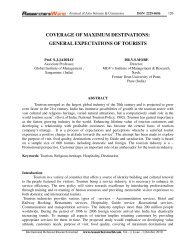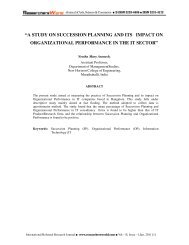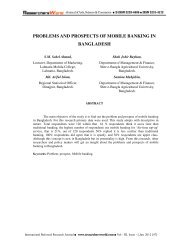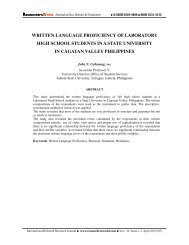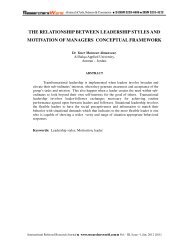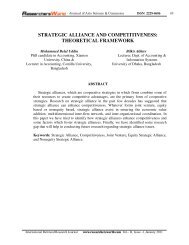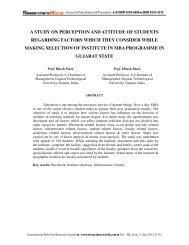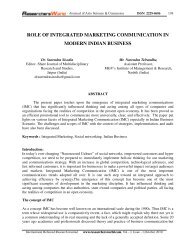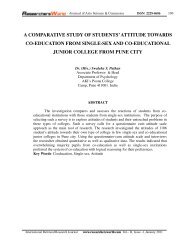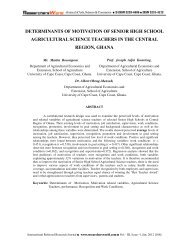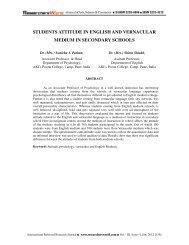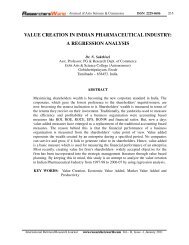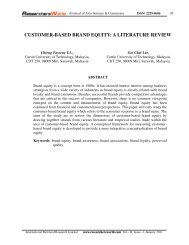settlement patterns and economic development - Researchers World
settlement patterns and economic development - Researchers World
settlement patterns and economic development - Researchers World
You also want an ePaper? Increase the reach of your titles
YUMPU automatically turns print PDFs into web optimized ePapers that Google loves.
-Journal of Arts, Science & Commerce ■ E-ISSN 2229-4686 ■ ISSN 2231-4172<br />
Vodafone,<br />
Tigo)<br />
MTN)<br />
More importantly, the 18 key informants in the indigene communities did indicate that most<br />
of the projects are initiated by external agents like NGOs <strong>and</strong> government (through the Twifo-<br />
Hemang-Lower Denkyira District Assembly).<br />
However, apart from the access roads linking these towns, most of the projects initiated in the<br />
settler <strong>and</strong> mixed communities are initiated by the chiefs <strong>and</strong> the community leaders or unit<br />
committees. The physical <strong>development</strong> projects found in these communities were undertaken through<br />
the communities’ own efforts <strong>and</strong> some support from NGOs. Does this suggest politicization of<br />
<strong>development</strong> projects? The answer is not so simple <strong>and</strong> straight forward, but some of the settler<br />
community members think so. For example, in the words of some settler respondents “…..we receive<br />
no government help because they say we do not vote for them during elections.” This is consistent<br />
with Orock’s (2005) research findings regarding impact of government projects in Doula-Cameroon<br />
that revealed a dichotomy in the indigene-settler relations. The Central Government’s l<strong>and</strong> policy,<br />
which for unexplained reasons engendered partisan politics gave privileges to indigenes over settlers<br />
that subsequently led not only to social exclusion for some groups in the community life, but also<br />
constrained their participation in <strong>development</strong>. This behavior of the government helps to intensify the<br />
perception that there is an indigene-settler divide- the idea that there are two grades of people - “sons<br />
of the soil’ (indigenes) <strong>and</strong> ‘foreigners’ (non-indigenes) within the same geographic location.<br />
The industry of the settler communities is also seen in the availability of cocoa shed to store<br />
their produce <strong>and</strong> also the fact many have changed their thatched roofing to aluminium sheets, which<br />
is more modern <strong>and</strong> an indication of progress or prosperity. This supports the finding of this study<br />
that indicates the settlers value self worth. Culturally, it gives a sense of fulfilment <strong>and</strong> satisfaction<br />
especially when their natives from their hometowns come to visit them. These visitors then take the<br />
information back home <strong>and</strong> narrate how well their family members are doing in foreign or non-native<br />
towns. The apparent better <strong>economic</strong> wellbeing of the settlers gives support to Unal’s (2007) claim<br />
that what matters is operated l<strong>and</strong> <strong>and</strong> not owned l<strong>and</strong> when it comes to agricultural productivity.<br />
The respondents unanimously did agree that the level of <strong>development</strong> in their communities is<br />
low <strong>and</strong> something needs to be done it. Consequently, the respondents were asked about what they<br />
think contributed to the low level <strong>development</strong> in their communities. The responses are discussed in<br />
the next section.<br />
CAUSES OF LACK OF DEVELOPMENT:<br />
Notwithst<strong>and</strong>ing the comparative ‘higher level’ of <strong>development</strong> executed in the indigene<br />
communities, 50% respondents attributed their unfulfilled <strong>development</strong> dreams mainly to weak<br />
national economy (Table 5). From their perspective (dependency view), <strong>development</strong> must come<br />
from outside- specifically from government <strong>and</strong> therefore weak national economy that reduces the<br />
government’s ability to initiate more projects constrains <strong>development</strong>. It is important to note that the<br />
two other groups did not mention the national economy as a factor of under<strong>development</strong>. Like the<br />
indigene communities, however, the mixed communities (30% <strong>and</strong> 18.7% respectively) identified<br />
lack of or poor communal spirit as a major cause of under<strong>development</strong>. The poor community<br />
participation does reflect the communities’ attitude towards communal labour or hard work in general.<br />
In the settler communities, high illiteracy rate, bad road network <strong>and</strong> generally poor infrastructural<br />
International Refereed Research Journal ■ www.researchersworld.com ■ Vol.– II, Issue –2,April 2011 211



